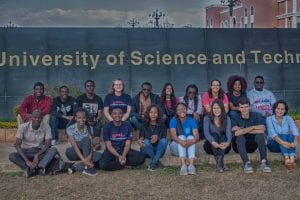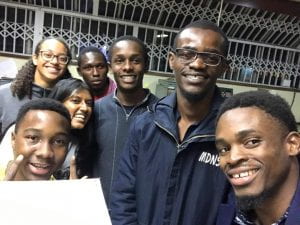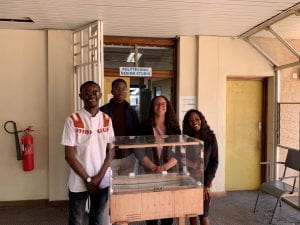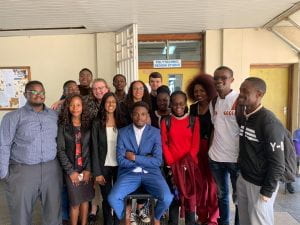Our last couple of days in Malawi were a whirlwind and I honestly can’t believe that it is over. Of course, we had a lot to do and not enough time, but part of the experience is making do with the time and resources available. On Monday, we were finally able to set up the first ever design studio at the Malawi University of Science and Technology (MUST). For majority of the summer, the design studio has been under construction, but we finally had the opportunity to view the space and at least begin the process of organizing and assembling the equipment. Due to time restraints, we only had the Rice and MUST students set up the new studio while everyone else continued to work on their projects. Our focus for the day was to get as much of the 3D printers built as possible, create an organized inventory check out system, label everything, and make sure all the laptops brought had the proper software. Unfortunately, we couldn’t finish everything we set out to accomplish given that we only had a day, but we made a good start and left and extensive list of tasks to improve the studio in the future. One day I hope I get the chance to see it in use knowing it will encourage students to learn through hands on experience.
under construction, but we finally had the opportunity to view the space and at least begin the process of organizing and assembling the equipment. Due to time restraints, we only had the Rice and MUST students set up the new studio while everyone else continued to work on their projects. Our focus for the day was to get as much of the 3D printers built as possible, create an organized inventory check out system, label everything, and make sure all the laptops brought had the proper software. Unfortunately, we couldn’t finish everything we set out to accomplish given that we only had a day, but we made a good start and left and extensive list of tasks to improve the studio in the future. One day I hope I get the chance to see it in use knowing it will encourage students to learn through hands on experience.
Tuesday, the final workday before presentations, was a long day to say the least. The only way to we were going to accomplish everything remaining in the project was to make design decisions together and then divide and conquer. Once deciding on the best way to approach completing the last portion of the project, Maureen and I worked on the final presentation, while Cholo and Tebogo started assembling the acrylic pieces. As we were making the presentation, we had to anticipate that our audience did not have prior knowledge of our project or the need we were trying to solve, yet technical engineering experience

as they were mainly professors. With that in mind, our main priority was to demonstrate the need to prevent hypothermia specifically during transportation between the wards, how it significantly impacts a neonate’s health, and how the device functions. After a tedious amount of time, we were able to include the information we wanted and now it was just a matter of making it presentable and easy to understand. By this point, majority of the students had left the studio and the rest of us came to terms that it was going to be a late night, so it was all hands on deck. After putting the last touches on the presentation, I began working on the device with the rest of the team. The device was almost done for the most part, we only had a few brackets to put secure the device which seemed simple enough, but took time working with acrylic and the size of our device. We did one last check to make sure everything was working properly (thankfully it did!) and we Eventually we are able to finish the device and it is a huge relief. Now all that remained was our big final presentation the next day.

On Wednesday morning, we were all a bundle of nerves for our presentation. For me personally, this was only my second formal engineering presentation, so I was especially nervous to say the least. As the time came near, we each practiced our presentation multiple times to ourselves and each other and made sure everything transitioned smoothly. Luckily our group was going third, so we had the opportunity to observe a few presentations before presenting. Before the first group presented, all the professors and Rice 360 engineers in the audience introduced themselves which only intimidated me more. The first two groups did an amazing job clearly describing the need for their device as well as how it works and handled questions from the audience with ease. Finally, it was our turn and there was no going back. During the presentation, everything went off without a hitch. We remembered to say all the additional information however the questions were more of a challenge. A few of the professors already had experience working with devices in the same field as ours and were more technical with our questions, but having only developed a first iteration, it gave us a lot to consider for future improvements. At the time it felt like we were under a lot of pressure, but we received nothing but positive.  Of course, there were questions about why we chose to design something a particular way or if we had considered doing something differently, but that is how progress is made. Obviously, these professors had way more experience and their criticisms could only improve our design and in the end help people. Walking away from that project, we had a long list of future improvements to make and design aspects to reconsider, but it could only get better from there. That last day in Malawi could not have ended better, with everyone together celebrating our accomplishment and looking to the future with hope.
Of course, there were questions about why we chose to design something a particular way or if we had considered doing something differently, but that is how progress is made. Obviously, these professors had way more experience and their criticisms could only improve our design and in the end help people. Walking away from that project, we had a long list of future improvements to make and design aspects to reconsider, but it could only get better from there. That last day in Malawi could not have ended better, with everyone together celebrating our accomplishment and looking to the future with hope.
-S